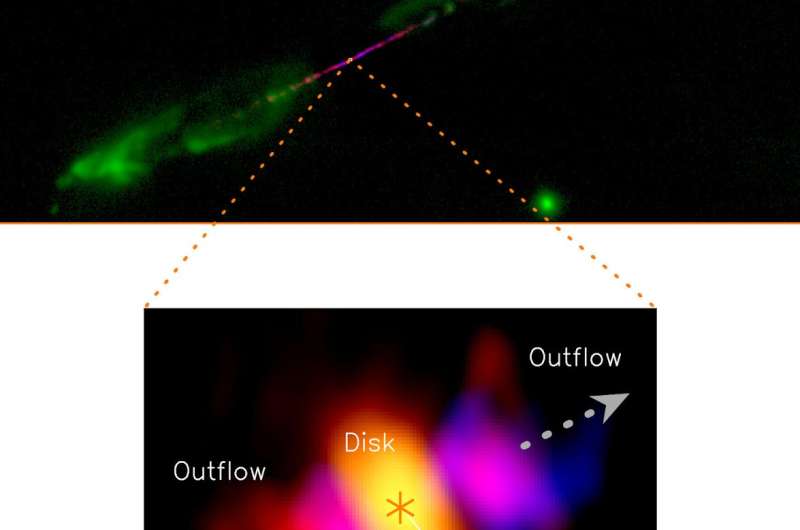Youngest accretion disk detected in star formation

An international team led by Chin-Fei Lee at the Academia Sinica Institute of Astronomy and Astrophysics (ASIAA) has discovered a very small accretion disk formed around one of the youngest protostars, with the Atacama Large Millimeter/submillimeter Array (ALMA). This discovery poses a constraint on current theory of disk formation stronger than before, by pushing the disk formation time by a factor of a few earlier. Moreover, a compact rotating outflow has been detected. It may trace a disk wind carrying away angular momentum from the disk and thus facilitate the disk formation.
"ALMA is so powerful that it can resolve an accretion disk with a radius as small as 15 astronomical units (AU)," says Chin-Fei Lee at ASIAA. "Since this disk is about a few times younger than the previously resolved youngest disk, our result has provided a stronger constraint on current theory of disk formation by pushing the disk formation time by a factor of a few earlier. Moreover, together with the previous results of the older disks, our disk result favors a model where the disk radius grows linearly with the protostellar mass, and thus supporting the 'early-start, slow-growth' scenario against the 'slow-start, rapid-growth' scenario for accretion disk formation around protostars."
HH 211 is one of the youngest protostellar systems in Perseus at a distance of about 770 light-years. The central protostar has an age of only about 10,000 years (which is about 2 millionths of the age of our Sun) and a mass of less than 0.05 solar mass. It drives a powerful bipolar jet and thus must accrete material efficiently.

Previous search at a resolution of about 50 AU only found a hint of a small dusty disk near the protostar. Now with ALMA at a resolution of 7 AU, which is about 7 times finer, the dusty disk at submillimeter wavelength not only has been detected but also spatially resolved. It is a nearly edge-on accretion disk feeding the central protostar and has a radius of about 15 AU. The disk is thick, indicating that the submillimeter light emitting grains have yet to settle to the midplane. Unlike the previously resolved older edge-on disk HH 212 which appears as a large "hamburger," this younger edge-on disk appears as a small "bun." Thus, it seems that an edge-on disk will grow from a small "bun" to a large "hamburger" in a later phase. Moreover, a compact rotating outflow has been detected, and it may trace a disk wind carrying away angular momentum from the disk and thus facilitate the disk formation.
The observations open up an exciting possibility of directly detecting and characterizing small disks around the youngest protostars through high-resolution imaging with ALMA, which provides strong constraints on theories of disk formation and thus the feeding process in star formation.
More information: Chin-Fei Lee et al. ALMA Observations of the Very Young Class 0 Protostellar System HH211-mms: A 30 au Dusty Disk with a Disk Wind Traced by SO?, The Astrophysical Journal (2018). DOI: 10.3847/1538-4357/aad2da
ALMA observations of the very young Class 0 protostellar system HH 211-mms: a 30-au dusty disk with a disk-wind traced by SO? arxiv.org/abs/1807.05336
Journal information: Astrophysical Journal
Provided by Academia Sinica Institute of Astronomy and Astrophysics




















